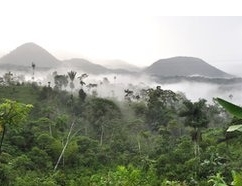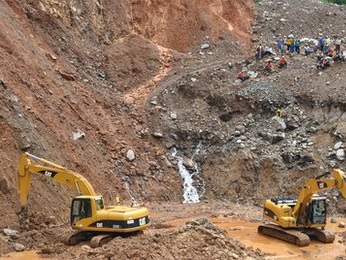Articles and News
REBEL DRUG LORDS FIND GOLD MINING MORE PROFITABLE THAN COCAINE | June 20, 2012 (0 comments)

Putomayo, Colombia—There's gold trouble brewing in them thar hills.
Reports seeping out from gold mining areas in Colombia (left) are chillingly reminiscent of Sierra Leone’s blood diamonds: rebel lords with big guns stand guard over hapless diggers and miners, extracting huge taxes on production and meting out swift—and sometimes final—retribution for any perceived infraction.
The region also is an environmental time bomb, as much of South America’s vast gold reserves lie under the delicate Amazon rainforest. Already there is significant evidence of deforestation, along with mercury and cyanide pollution (from refining the ore) in nearby rivers.
For luxury jewelers already dealing with gold price volatility, this is a new worry. On the upside, the huge influx of recycled gold from street buying can provide a buffer against dirty or conflict gold, but that won't matter to NGOs who like to make luxury industries their first publicity targets.
Peru is the largest gold producer in South America, but Colombia’s reserves are massive as well, and seven other nations on the continent also have gold reserves. And according to this article on BBC News, gold is making Colombia’s other notorious cash crop, cocaine, a lot less attractive. Between the sustained high price of gold and more aggressive drug laws biting into profits, rebels and drug lords are diversifying and getting into both legal and illegal gold mining.
Gold is legal to produce and sell, unlike coca plants or cocaine. But gold, along with tungsten, tantalum, and tin, is one of four minerals named in a provision buried deep in the U.S. Dodd-Frank law that aims to stop the flow of conflict minerals from the Democratic Republic of Congo in Africa. The little-known provision requires American public companies to independently audit their supply chains to ensure no minerals come from mines linked to militia groups in either the DRC or adjoining countries.
At present, Dodd-Frank applies only to those nine nations, but it's not inconceivable the provision could be expanded to cover other conflict regions. Cecilia Gardner, CEO of the Jewelers’ Vigilance Committee, says once Dodd-Frank comes into effect, retailers will have to ask gold suppliers about the origin of their gold anyway, so she advises a proactive stance and suggests jewelers start asking now. Even if the law says “public companies,” knowing your gold is clean can only help an independent jeweler if a local investigative news team comes calling.

An illegal gold mine in Colombia. Both photos, BBCNews.com
On the good side, rocketing gold prices are helping to bring economic prosperity to South America, just as diamonds have done for Africa. The continent is experiencing huge migratory shifts of workers to mining, and South American politicians are working hard to bring foreign investment into the mining industry in hopes of improving the lives of their citizens. But the downside is that even as the politicians see profit opportunities, so do the bad guys. And so far, the rebels—often better armed and better trained than their African diamond counterparts—are benefiting much more than the workers.
According to the BBC article, one official in Putomayo province estimates the Revolutionary United Forces of Colombia (FARC) makes about $450,000 a month in illegal gold profits there. Another BBC article says not only are rebels getting the lion’s share of the mineral wealth without paying taxes on it, but South American governments also are trying to deal with a rise of lawless encampments around the mines where, among other crimes, sexual exploitation of women is commonplace. Rebels go on recruitment drives among citizens; sometimes with enticements like football (soccer) tournaments, and sometimes with “invitations” to political meetings where attendees are forced to listen to Marxist doctrine.
The real authorities can’t do much, according to the BBC. In March, it says, Colombian police sent in investigators to try and find out how much gold was being mined, but quickly realized that nothing short of a massive army strike was going to work. In fact, in one area, police are afraid even to leave their station, a series of underground bunkers.
Industry action. The World Gold Council is committed to the development of a sustainable gold mining industry, where responsibly produced gold contributes to the economic development of the communities and countries where it’s mined. And with the adoption of its “Conflict-Free Gold Standard,” the Council already has begun taking steps to try and ensure the supply chain stays clean. (Download the brochure detailing the CFGS here.)
“The World Gold Council believes that the mining of gold should be a source of economic and social development wherever it is found. We are opposed to activities which, directly or indirectly, finance or benefit armed conflict and violence that contributes to human rights abuses and breaches of international humanitarian law. The objective of our Standard is to create absolute trust that the gold produced under its guidelines neither fuels armed conflict, nor funds armed groups, nor contributes to human rights abuses associated with these conflicts. The Standard is designed to apply globally, for World Gold Council members and other companies involved in the extraction of gold,” says the WGC.
Aside from the FARC and other armed rebel groups, there’s also garden-variety illegal mining there. In March, miners in Peru clashed with police over tougher penalties for illegal gold mining. Miners say tougher regulations will put them out of work; the government thinks the sanctions will encourage miners to get the required permits. Three people died and 30 were injured in that skirmish, says this article.
The best way to stanch supply is to curtail demand. That’s what the Kimberley Process is designed to do for ill-begotten diamonds. But determining origin is even harder for gold than diamonds. Once gold has been refined from the original ore, it’s essentially impossible to tell where it came from. So dirty gold can easily be mixed with clean or even recycled material.
At present, Dodd-Frank is the only “Kimberley-like” regime for gold, says Gardner, emphasizing again that the best defense is a good offense.
“Some large chains have already begun asking their gold jewelry suppliers to start asking their suppliers for origin,” she told The Centurion. And, while the situation is still largely under the radar, it may not be for long. “The NGOs are already quite active in this area,” she added.







